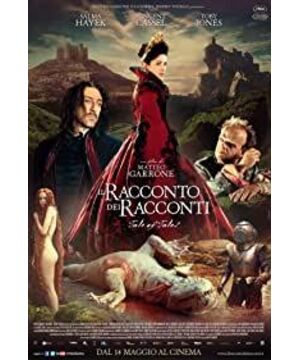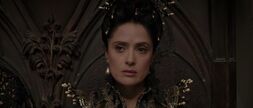Retell the story briefly. (Please take a detour if you haven't watched the film, I have already reminded it with friendship) The film tells the story of the three kingdoms. In the first kingdom, the king and his wife wanted to have a child. The black-robed warlock visited mysteriously and gave the prescription: take out the heart of the water monster, find a virgin to cook, and let the queen eat it to get pregnant. The kings followed suit in turn. The king was injured and died in the process of killing the sea monster, but the king gave birth successfully. The maid who cooks the heart is also conceived during the cooking process. The sons of the prince and the maid look exactly like twins. The queen has been desperately preventing the prince and the "brother" from getting tired of being together, but fate has long since concluded the two children together. The violence used by the queen to give birth must be repaid with violence. In the end, in order to recall her son, she turned into a monster and wanted to kill the maid's son, but was stabbed to death by her own son who had arrived.
In the second story, the king played by Vincent Caso is an obscene sensual. One day he was attracted by the girl’s singing and wanted to possess that girl. However, the girl’s voice actually came from an ugly old woman who used a plan to make peace in the dark. The king copulated, and the king who finally saw the truth about the old woman had a panic attack and threw her from the tower. The old woman fell into the jungle and was rescued by a witch. She was breast-fed and turned the old woman into a beautiful girl. She was then discovered again by the hunting king, shocked as a god, and married as a queen. The sister of the old woman at the wedding banquet couldn't believe what happened before her. She also wanted to regain her youth like her sister. She could only be shaved blood in reality. And all magic is time-limited.
In the third story, the dwarf king has a secret. He used his own blood to raise a jumper the size of a dog. After the jumper died, he used the jumper as a mystery. Those who guessed it could win and marry him. The only daughter. He thought that he could use this to let his daughter accompany him to the end of his life, but he didn't expect that a half-orc suddenly appeared in the crowd, and he guessed right and took the princess away. The princess struggled in every possible way, but the king insisted on keeping his promise. The princess who was taken away suffers in the mountain-top cave of the half-orcs until she meets a kind-hearted family to rescue her and throw Oakes down into the valley. It should have been a turn of events, but the half-orcs once again attacked and killed a family. The princess ran away, facing the half-orc who truly loved her, she could no longer escape, and finally snuggled on his back, and then gave him a throat cut. The princess returned to her father's palace with the head of the orc. The king knelt before her. The princess was crowned.
As a veteran ashes fan, first of all, Desplat's music is very right. There are shops all over the place, but fortunately, the work is really good and tolerable. When I watched halfway through, I wanted to say that anyone can write a bunch of black fairy tales like this and throw them out, but these three stories in the film go farther than the black fairy tales I understood at first. Because dark fairy tales are not just anti-fairy tales and a reversal of conventional narratives, but also seduce the endless realistic logic behind the story in the narrative. What's the point of simply adapting a few fairy tales from the Naples dialect story collection 400 years ago?
What's interesting and unusual about the film is that in the process of each story narration, the hint to the story's footing keeps sliding. As the title "Story of Stories" implies. In the process of watching the narrative, the audience must take the initiative to speculate constantly, constantly failing and losing. Only at the end of the film did it seem to be able to find a foothold. The fairness of destiny, the rewards of gains and losses, and the argument that the capable should be self-improving are things that can be seen in the story's mother "Five Days". In addition, I can still feel the theme of Italian movies that has not changed since Pasolini's time: the struggle between the children and their parents, or how the children's growth alone is responsible for their destiny. (It can be seen that the director Garrone wants to be a big shot.) The last tightrope walker in the volley, expressing the key words of fate, fairness and courage in a subtle way. Standing on the opposite side of fairy tales' praise of "truth, goodness and beauty", "Story of Stories" presents the cruelty of reality, the indomitable struggle between individuals and destiny. There is no natural luck, power or beauty, and no happy flowers that never die. Garrone is definitely not a leftist in the general sense. His adoration of the strong and his cruel protection of his fate reveal this.
But these intentions are just nonsense, to be honest, they are a last resort. What post-modern fairy tales are most opposed to is the logic and original intention constructed by fairy tales (or all traditional narratives). But he must put in some hidden themes for the audience to express. The queen eats heart, the king kills monsters underwater, the old woman "plasticizes", the king raises giant jumpers, the princess cuts his throat and half orcs... These "horrible" story elements are dressed in cloaks of black fairy tales and witchcraft. The mission to disperse the deep thinking space of images. Garrone strives to use the sculpting of each lens to magnify the suggestive information it can convey, in order to disperse and disintegrate the "story focus" provided by a traditional linear narrative. He hopes to use the "horrifying eyes and ears" of the image to keep the audience's attention only On its surface. I don't know if he is successful, anyway, I saw him secretly carry private goods in the connotation of the story according to his own worldview. Self-contradiction is certain. Because film is still a product of modernity in the final analysis. And this era has been half a century away from modernity.
To reiterate the old saying: From an implicit point of view, Antonioni has already taken the film as a way of worldview. Aesthetically speaking, Abbas has also taken the film as a way of art. Of course, in terms of style, there are still many innovations that can be tried. For example, in this film, the director takes the book to explain clearly the style he wants. Others, photography, art, costumes, actors, and music, you guys go busy, there is nothing you don't understand or entangled. It is worthy of complimenting you to be able to make art, scenery, props and costumes in place, after all, it is also considered to have made a great contribution to the fullness of the image. The most important thing is photography and performance. It must serve the drama accurately and not leave room for the audience to think away from the story.
Don't be entangled with deep-seated things, it is the top priority of the success of popular movies in this era. Narrative pleasure and image saturation are more important than anything else. Like the "text fragments" Weibo with up to 140 characters, in the "space-time fragments" movie, the story elements are put up concisely and concisely. The smart audience can naturally appreciate other connotations from the space outside the fragments, most of the " "Other" audiences can also get illusory pleasure in the bloody violence. This film was made according to this path, so it is safe. Security is of course good, but it is also boring. From the beginning of "Gamola", Garrone has been an excellent craftsman who relied on the plot (dramatic) to win and worked hard.
Every movie, we should look at it vertically in the entire movie history. The film was named "Story of Stories", but in this sliding narrative, what I saw was "movies of movies". Directors of this era, if they really want to make a film with a "movie view" in a sincere way, don't commit suicide.
for "Universal Screen"
View more about Tale of Tales reviews











